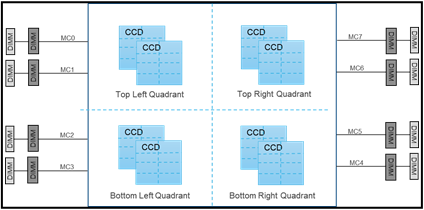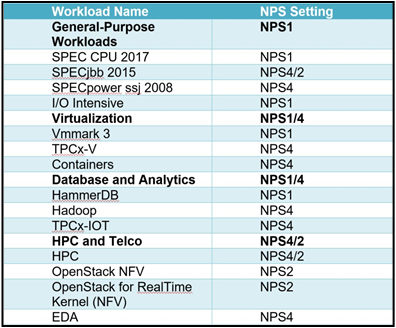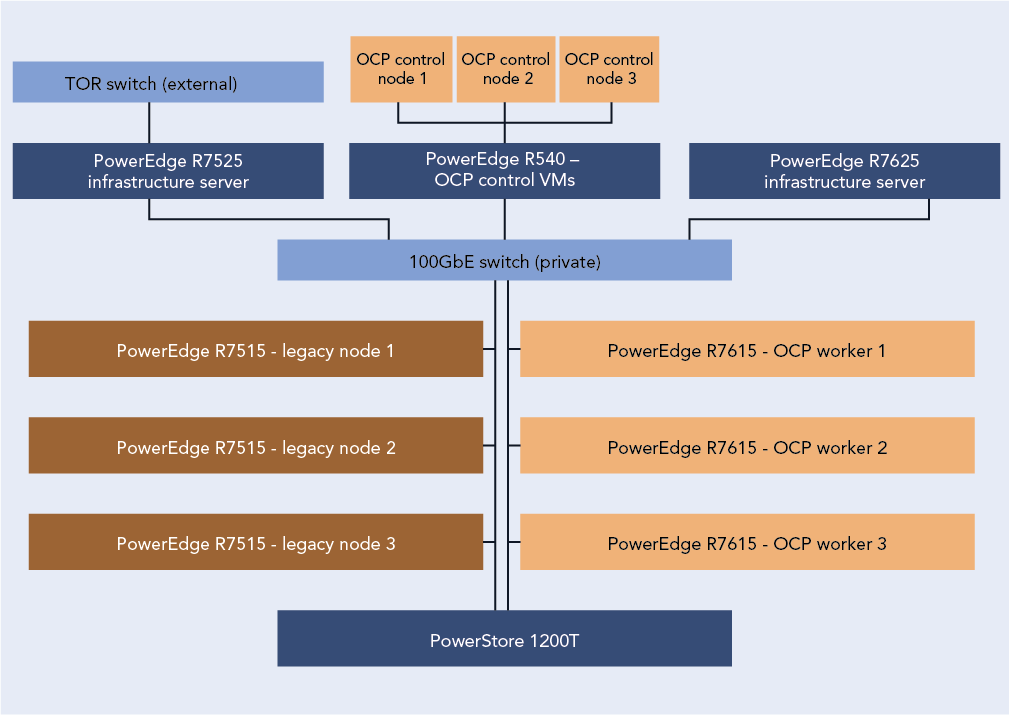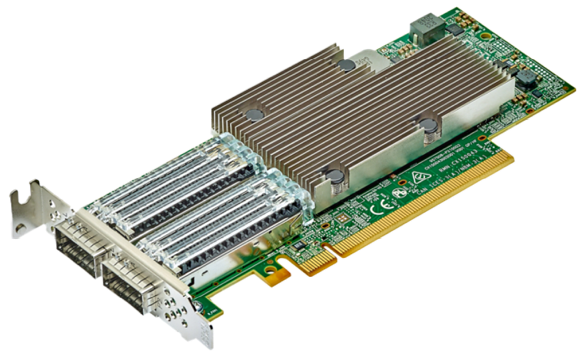

NUMA Configuration settings on AMD EPYC 2nd Generation
Download PDFMon, 16 Jan 2023 13:44:26 -0000
|Read Time: 0 minutes
Summary
In multi-chip processors like the AMD-EPYC series, differing distances between a CPU core and the memory can cause Non- Uniform Memory Access (NUMA) issues. AMD offers a variety of settings to help limit the impact of NUMA. One of the key options is called Nodes per Socket (NPS). This paper talks about some of the recommended NPS settings for different workloads.
Introduction
AMD Epyc is a Multi-Chip Module processor. With the 2nd generation AMD EPYC 7002 series, the silicon package was modified to make it a little simpler. This package is now divided into 4 quadrants, with up to 2 Core Complex Dies (CCDs) per quadrant. Each CCD consists of two Core CompleXes (CCX). Each CCX has 4 cores that share an L3 cache. All 4 CCDs communicate via 1 central die for IO called I/O Die (IOD).
There are 8 memory controllers per socket that support eight memory channels running DDR4 at 3200 MT/s, supporting up to 2 DIMMs per channel. See Figure 1 below:

Figure 1 - Illustration of the ROME Core and memory architecture
With this architecture, all cores on a single CCD are closest to 2 memory channels. The rest of the memory channels are across the IO die, at differing distances from these cores. Memory interleaving allows a CPU to efficiently spread memory accesses across multiple DIMMs. This allows more memory accesses to execute without waiting for one to complete, maximizing performance.
NUMA and NPS
Rome processors achieve memory interleaving by using Non-Uniform Memory Access (NUMA) in Nodes Per Socket (NPS). The below NPS options can be used for different workload types:
- NPS0 – This is only available on a 2-socket system. This means one NUMA node per system. Memory is interleaved across all 16 memory channels in the system.
- NPS1 – In this, the whole CPU is a single NUMA domain, with all the cores in the socket, and all the associated memory in this one NUMA domain. Memory is interleaved across the eight memory channels. All PCIe devices on the socket belong to this single NUMA domain.
- NPS2 – This setting partitions the CPU into 2 NUMA domains, with half the cores and memory in each domain. Memory is interleaved across 4 memory channels in each NUMA domain.
- NPS4 – This setting partitions the CPU into four NUMA domains. Each quadrant is a NUMA domain, and memory is interleaved across the 2 memory channels in each quadrant. PCIe devices will be local to one of the 4 NUMA domains on the socket, depending on the quadrant of the IOD that has the PCIe root for the device.
Note: Not all CPUs support all NPS settings
Recommended NPS Settings
Depending on the workload type, different NPS settings might give better performance. In general, NPS1 is the default recommendation for most use cases. Highly parallel workloads like many HPC use cases might benefit from NPS4. Here is a list of recommended NPS settings for some key workloads. In some cases, benchmarks are listed to indicate the kind of workloads.

Figure 2 - Table of recommended NPS Settings depending on workload
For additional tuning details, please refer to the Tuning Guides shared by AMD here.
For detailed discussions around the AMD memory architecture, and memory configurations, please refer to the Balanced Memory Whitepaper
In Conclusion
The Dell AMD EPYC based servers offer multiple configuration options to optimize memory performance. Based on workload, choosing the appropriate NPS setting can help maximize performance.
Related Documents

Benchmark Performance of AMD EPYC™ Processors
Mon, 16 Jan 2023 23:40:30 -0000
|Read Time: 0 minutes
Summary
The Dell PowerEdge portfolio of servers with AMD EPYC processors have achieved several world record benchmark scores including VMMark, TPCx-HS and SAP-SD. These scores demonstrate the advantage of these servers for key business workloads.
AMD 3rd Generation AMD EPYC™ Processors
The 3rd Generation of AMD EPYC™ Processors builds on the AMD Infinity Architecture to provide full features and functionality for both one-socket and two-socket x86 server options. The processor retains the chiplet design from the 2nd generation, with a 12nm based IO die surrounded by 7nm based compute dies and is a drop-in replacement option. With a range of options, from 8 cores all the way to 64 cores, and TDPs of up to 280W, these processors can target a wide variety of workloads. Configurations support up to 160 lanes of PCIe Gen4 allowing for options like 24x direct attach NVMe drives and dual port 100Gbps NICs that can run at line rate.
Key New Features
The AMD 3rd Generation of processors builds on the previous generation but adds a few key optimizations that deliver significant performance improvements. The L3 cache in each CCD is now shared across all 8 cores instead of just 4. Thus, each core has up to 32MB of L3 cache allowing for flexibility, lower inter-core latency, and improved cache performance. The DDR memory latency has been further reduced along with a new 6-channel memory interleaving option. The IO memory management unit has been optimized to better handle 200Gbps line rate. There is improved support for Hot Plug surprise remove following PCIe-SIGs new implementation guideline. New features like SEV-SNP (Secure Nested Paging) provide enhanced virtualization security. There are a few other enhancements and optimizations targeting workloads around HPC, etc.
What does this mean?
Technical specifications can only explain part of the story. Key workload-based benchmarks can explain some of the real-world applicability and real-world performance. Dell has worked to publish multiple key benchmarks to help customers gauge the real-world performance of the various Dell PowerEdge servers with AMD EPYC Processors
Key Benchmarks
Some of the key benchmarks that are relevant to typical use cases are listed below:
VMMark:
VMMark is a benchmark from VMWare that highlights virtualization. The VMMark benchmark runs multiple tiles on the system under test. Each tile consists of 19 different virtual machines, with each running a typical workload. This benchmark is great at identifying the capabilities for a typical IT server where the workloads are virtualized, and multiple workloads are running on a single server.
For AMD, EPYC, the large number of cores, the high speed memory, the high speed PCIe Gen4 for networking, and, when used, storage, all contribute towards a very positive result.
As of 3/15/2021, Dell has top scores on 4-node vSAN configurations with the R7515, the R6525 and the C6525. The R7515 and R6525 are 1 and 2-Socket servers with scores of 15.18@16 tiles and 24.08@28 tiles respectively. The C6525 is a modular server with 4-nodes in a single 2-U system with a score of 13.74@16 tiles and highlights the sheer density of compute possible in 2U of rack space.
Dell also has a leading score for a matched pair 2-socket configuration connected to a Dell EMC PowerMax. This configuration managed a score of 19.4@22 tiles from just 2 servers, achieving the maximum VM density for such a configuration. This score highlights the advantages of leveraging an excellent external storage array like the Dell EMC PowerMax to maximize reliability and performance.
Reference: https://www.vmware.com/products/vmmark/results3x.html
TPCx-HS
The TPCx-HS benchmark is built to showcase the performance of a Hadoop cluster doing data analytics. In today’s world, where data is critical, the ability to analyze and manage this data becomes very important. The benchmark can do batch processing with MapReduce or data analytics on Spark
As of 3/15/2021, Dell PowerEdge servers with AMD EPYC 3rd generation of processors have multiple world record scores for TPCx-HS at both the 1TB and 3TB database sizes. These include performance improvements of as much as 60% over the previous world records with as much as 40% lower $/HSph.
Reference: http://tpc.org/tpcx-hs/results/tpcxhs_perf_results5.asp?version=2
SAP-SD
SAP-Sales and Distribution is a core functional module in SAP ERP Central Component that allows organizations to store and manage customer and product related data. The ability to access and manage this data at high speed, and with minimal latency is a very critical requirement of the business architecture.
For this benchmark, Dell PowerEdge servers have world record scores on Windows and Linux for both 1-S and 2-S platforms. The 2-S Linux configuration score of 75000 benchmark users is higher than even the best 4-S score for this benchmark, highlighting the significant advantage of this architecture for database use cases.
Reference: https://www.sap.com/dmc/exp/2018-benchmark-directory/#/sd
Conclusion
Dell PowerEdge servers with AMD EPYC processors have industry leading performance numbers. Benchmarks like VMMark, TPCx-HS and SAP-SD show that these platforms are excellent for the most common workloads and provide excellent business value.

Improve performance by easily migrating to a modern OpenShift environment on PowerEdge R7615 servers
Tue, 14 May 2024 20:15:19 -0000
|Read Time: 0 minutes
Improve performance and gain room to grow by easily migrating to a modern OpenShift environment on Dell PowerEdge R7615 servers with 4th Generation AMD EPYC processors and high-speed 100GbE Broadcom NICs
We deployed this modern environment, then migrated database VMs from legacy servers and saw performance improvements that support consolidation.

Transactional databases are the backbone of many business operations, powering ecommerce and order fulfillment, human resources and payroll, and a host of other activities. If your company is running these kinds of workloads on server infrastructure that is several years old, you might believe that performance is adequate and that you have little reason to consider upgrading to new servers with modern processors, networking, and a Red Hat® OpenShift® container-based environment. In fact, by continuing to use this older gear, you could be incurring higher than necessary operating expenditures by maintaining and powering more servers than you need to perform a given volume of work. You could also be risking downtime with aging hardware that is likelier to break down. By upgrading to a modern environment, you could mitigate these issues and future-proof your infrastructure. A 2019 Forrester Consulting report recommended that organizations refresh their servers at least every three years to maximize agility and productivity.[1] The report states not only that modern servers allow organizations to adopt more emerging technologies at a faster rate, but also “modern hardware has a profound impact on business benefits such as better customer experience, employee productivity, and innovation.”[2]
We explored the process of migrating VMs from a legacy environment and conducted testing to quantify the resulting improvements in network and database performance. We started with a legacy environment consisting of MySQL™ virtual machines (VMs) running on a cluster of three Dell™ PowerEdge™ R7515 servers with 3rd Generation AMD EPYC™ processors and 25Gb Broadcom® NICs. We then deployed a modern OpenShift container-based environment comprising three Dell PowerEdge R7615 servers with 4th Generation AMD EPYC processors and high-speed 100Gb Broadcom NICs. While the primary application of OpenShift is typically for containerized workloads, we used OpenShift Virtualization, which presents a familiar VM layer to administrators while utilizing the containerized technology on the underlying layer. Both environments used a Dell PowerStore 1200T for external storage that the servers accessed using iSCSI. We measured database performance using the HammerDB TPROC-C benchmark.
We found that the modern cluster environment of Dell PowerEdge R7615 servers with 4th Generation AMD EPYC processors and high-speed 100Gb Broadcom NICs outperformed the legacy cluster environment, delivering 44 percent greater database performance. These improvements mean that companies that upgrade can enjoy savings by meeting their workload requirements with fewer servers to license, maintain, power, and cool. Selecting 100Gb Broadcom NICs also positions companies well to take advantage of increasingly popular network-intensive technologies such as artificial intelligence (AI).
The benefits of containerization and Red Hat OpenShift Virtualization
Many organizations choose containers for DevOps due to their easy scalability and portability. Because a container encapsulates an application as well as everything necessary to run that application, it’s simple to move the container from development to test and production environments, adding instances of the application by replicating the container. Containers can also be useful for microservices, data streaming, and other use cases.[3]
Containers aren’t necessarily ideal for every use case, however, and for some infrastructures, IT teams may wish to incorporate both containers and VMs. Red Hat OpenShift Virtualization, which we used in our testing, enables organizations to run both VMs and containers on the same platform by bringing VMs into containers.[4] This lets IT reap the benefits of both containers and VMs with the efficiency benefit of relying on one management tool, rather than having to maintain two distinct infrastructures.
About our testing
We explored the process of deploying a modern data center environment and migrating VMs to it from a legacy environment. We also measured the database performance the VMs achieved in both environments:
Legacy environment
- Three Dell PowerEdge R7515 servers with 3rd Generation AMD EPYC 7663 56-core processors and Broadcom Advanced Dual 25Gb Ethernet NICs
- External storage using Dell PowerStore 1200T over iSCSI
- VMware® vSphere® 8
Modern environment
- Three Dell PowerEdge R7615 servers with 4th Generation AMD EPYC 9554 64-core processors and Broadcom NetExtreme-E BCM57508 100GB NICs
- External storage using Dell PowerStore 1200T over iSCSI
- Red Hat OpenShift 4.14
Figure 1 presents a diagram of our test configuration. In addition to our test server clusters, we needed three servers to host infrastructure VMs, workload client VMs, and the OpenShift control node VMs. We configured a Dell PowerEdge R7525 to serve as the host for our infrastructure VMs for services such as AD, DHCP, and DNS, as well as HammerDB client VMs. We also configured a Dell PowerEdge R7625 to host additional HammerDB client VMs. For the OpenShift environment, we deployed a Dell PowerEdge R540 to host the OCP control nodes. We virtualized the control nodes to reduce the number of servers needed for the test bed.

Figure 1: Our test configuration. Source: Principled Technologies.
To test the MySQL database performance of each environment, we used the TPROC-C workload from the HammerDB benchmark. HammerDB developers derived their OLTP workload from the TPC-C benchmark specifications; however, as this is not a full implementation of the official TPC-C standards, the results in this paper are not directly comparable to published TPC-C results. For more information, please visit https://www.hammerdb.com/docs/ch03s01.html.
Each VM had a single MySQL instance with a TPROC-C database. We targeted the maximum transactions per minute (TPM) each environment could achieve by increasing the user count until performance degraded.
What we learned
Finding 1: Deploying OpenShift in the modern environment was easy
For our environment, the OpenShift installation process using the Red Hat Assisted Installer to install an OpenShift Installer-Provisioned Cluster was straightforward and simple. We started by setting up the prerequisites for the environment, which included a VM for Active Directory, DNS, and DHCP. We created a domain for our private network and added the API and ingress routes as DNS A records. Next, we set up a VM as a router so that our OpenShift environment could access the internet from our private network. Finally, we created three blank VMs to serve as our OpenShift controller nodes. Once we had met the pre-requisite requirements, we logged into the Red Hat Hybrid Console and navigated to the Assisted Installer to create the cluster.
The Assisted Installer streamlined the process by walking us through configuration menus for storage, network, and access to the cluster. We started the cluster creation by assigning it a name, providing the domain, and selecting an OpenShift version. From there the installer guided us through the process of providing an installer image using the SSH public key of the server running the installer. After downloading the ISO, we booted each of the controller and worker nodes into the image and the Assisted Installer discovered each node. After discovering the controller and worker nodes, the installer walked us through the rest of the configuration process and then began the installation. The Assisted Installer made the process very simple with only six configuration tabs to advance through, and with our total install time after configuration taking around three hours. Once the installation was complete, each node rebooted into the OpenShift OS and the Assisted Installer provided us with a cluster console fully qualified domain name (FQDN) to connect to and manage the cluster from. For detailed steps on the OpenShift deployment process, see the science behind the report.
Finding 2: Migrating VMs from the legacy VMware environment to the modern OpenShift environment was easy
Migrating a VM from the VMware environment to OpenShift was also a straightforward process and quick to set up. While the actual migration time will vary depending on VM size and hardware speed, the setup consists of only a few steps and took us less than 10 minutes. We first installed the Migration Toolkit for Virtualization from the OpenShift OperatorHub. We then entered the IP address and credentials for the vCenter as a new provider. Next, we created a NetworkMap and a StorageMap to connect the respective resources between the environments. We then created a new migration plan to map the VMs to a namespace in OCP. We ran the migration plan on a single VM, and confirmed that we were able to enter the VM console once the migration was complete. For detailed steps on the process of migrating VMs from the legacy environment to the modern environment, see the science behind the report.
About 4th Gen AMD EPYC 9554 processors
According to AMD, EPYC 9554 processors deliver fast performance “for cloud, enterprise, and HPC workloads—helping accelerate your business.”[5] EPYC processors include AMD Infinity Guard, which per AMD is “a set of layered, cutting-edge security features that help you protect sensitive data and avoid the costly downtime cause by security breaches.”[6]
In addition to performance and security features, AMD claims their processors are energy-efficient, which can reduce energy costs and “minimize environmental impacts from data center operations while advancing your company’s sustainability objectives.”[7]
When comparing SPECCPU Floating Point peak rates and the default thermal design power (TDP) of the AMD EPYC 9554 and the AMD EPYC 7663, the 9554 has 54 percent better performance per watt, which demonstrates the improved power efficiency with the new 4th Gen AMD EPYC process.[8],[9]
For more information about 4th Gen AMD EPYC processors visit: https://www.amd.com/en/processors/epyc-server-cpu-family.
Finding 3: Database performance improved by 44 percent in the new environment
Figure 2 shows the results of our database performance testing using the TPROC-C workload from the HammerDB benchmark suite. The modern OpenShift cluster of Dell PowerEdge R7615 servers outperformed the legacy cluster by 44 percent. This extra capability could benefit companies upgrading to the new environment in several ways. The company could provide a better user experience, perform more work—or support more users—with a given number of servers, or reduce the number of servers necessary to execute a given workload.

Figure 2: Performance in transactions per minute using the TPROC-C workload of the HammerDB benchmark suite. Higher is better. Source: Principled Technologies.
Finding 4: Performance improved in the modern cluster, supporting consolidation, which leads to savings
Based on the results of our performance tests (see Figure 3), a company could consolidate the database workloads of a four-node Dell PowerEdge 7515 cluster with some additional headroom into three modern Dell PowerEdge R7615 servers with 4th Generation AMD EPYC processors and high-speed 100Gb Broadcom NICs.
The cluster of three modern servers delivered a total of 9,674,180 transactions per minute (3,224,726 TPMs per server). The cluster of three legacy servers delivered a total of 6,714,712 TPM (2,238,237 per server). Based on these results, four legacy servers would achieve a total of 8,952,948 TPM, which would leave 721,231 additional TPM room for growth on the modern three-node cluster.
Reducing the number of servers you need means that operational expenditures such as data center power and cooling and administrator time for maintenance also decrease, leading to ongoing savings.

Figure 3: Performance in transactions per minute that three modern servers and four legacy servers could achieve, based on our hands-on testing. Higher is better. Source: Principled Technologies.
About Dell PowerEdge R7615 servers
The Dell PowerEdge R7615 is a 2U, single-socket rack server. Dell states that it has designed this server to provide “performance and flexible, low-latency storage options in an air or Direct Liquid Cooling (DLC) configuration.”[10]
According to Dell, this server uses the AMD EPYC 4th generation processor to deliver up to 50 percent higher core count per single-socket platform in an innovative air-cooled chassis.[11] It also supports DDR5 at 4800 MT/s memory and PCIe® Gen5 with double the speed of previous Gen4 for faster access and transport of data, optimizing application output.[12] It supports up to six single-wide full-length GPUs or three double-wide full-length GPUs, to improve responsiveness or reduce app load time for power users, plus lower-latency, high-performance NVMe SSDs to help maximize compute performance.[13]
Learn more at https://www.delltechnologies.com/asset/en-us/products/servers/technicalsupport/poweredge-r7615-spec-sheet.pdf.
How high-speed 100Gb Broadcom NICs can help your organization
Even if a 25Gb NIC is sufficient to meet a company’s current networking needs, opting to equip new servers with the high-speed 100Gb Broadcom NIC can be a smart move. Future-proofing your network can allow you to meet the increasing demands of emerging technologies.
Advanced technologies such as artificial intelligence and machine learning, which can require the processing and transmission of large amounts of data, are becoming increasingly prevalent across businesses of all sizes. In a June 2023 survey of small business decision-makers, 74 percent were interested in using AI or automation in their business and 55 percent said their interest in these technologies had grown in the first half of 2023.[14] Upgrading to a modern environment with a highspeed 100Gb Broadcom NIC positions companies to take advantage of AI applications for social media, content creation, marketing, customer support, and many other use cases.
Another way that investing in the high-speed 100Gb Broadcom NIC can help your company is through improved efficiency. You might be tempted to go with a 25Gb NIC, thinking that as your networking needs increase, you can simply add more NICs of this size. However, consider a 2023 Principled Technologies study that compared the performance of a server solution with a 100Gb Broadcom 57508 NIC and a solution with four 25Gb NICs.[15] Testing revealed that the 100Gb NIC solution achieved up to 2.3 times the throughput of the solution with 25Gb NICs. It also delivered greater bandwidth consistency, which can translate to providing a better user experience; the report states that applications using the 25Gb NICs network configuration “would experience significant variation in available bandwidth, potentially causing jittery or interrupted service to multiple streams.”[16]
About the Broadcom BCM57508-P2100G Dual-Port 100GbE PCle 4.0 ethernet controller
A higher performing NIC can reduce latency, increase throughput, and allow the server to transmit and receive a great volume of data. The Dell PowerEdge R7615 we tested features the Broadcom BCM57508-P2100G DualPort 100GbE PCle 4.0 ethernet controller, which supports speeds of up to 200 Gigabits per second. Broadcom designed the BCM57508-P2100G “to build highlyscalable, feature-rich networking solutions in servers for enterprise and cloud-scale networking and storage applications, including high-performance computing, telco, machine learning, storage disaggregation, and data analytics.”[17]
The BCM57508-P2100G features BroadSAFE® technology, “to provide unparalleled platform security” and a “unique set of highly-optimized hardware acceleration engines to enhance network performance and improve server efficiency.”[18]
 BCM57508-P2100G Dual-Port 100GbE PCle 4.0 ethernet controller. Image provided by Dell.
BCM57508-P2100G Dual-Port 100GbE PCle 4.0 ethernet controller. Image provided by Dell.
Conclusion
If your organization’s transactional databases are running on gear that is several years old, you have much to gain by upgrading to modern servers with new processors and networking components and an OpenShift environment. In our testing, a modern OpenShift environment with a cluster of three Dell PowerEdge R7615 servers with 4th Generation AMD EPYC processors and high-speed 100Gb Broadcom NICs outperformed a legacy environment with MySQL VMs running on a cluster of three Dell PowerEdge R7515 servers with 3rd Generation AMD EPYC processors and 25Gb Broadcom NICs. We also easily migrated a VM from the legacy environment to the modern environment, with only a few steps required to set up and less than ten minutes of hands-on time. The performance advantage of the modern servers would allow a company to reduce the number of servers necessary to perform a given amount of database work, thus lowering operational expenditures such as power and cooling and IT staff time for maintenance. The high-speed 100Gb Broadcom NICs in this solution also give companies better network performance and networking capacity to grow as they embrace emerging technologies such as AI that put great demands on networks.
This project was commissioned by Dell Technologies.
May 2024
Principled Technologies is a registered trademark of Principled Technologies, Inc.
All other product names are the trademarks of their respective owners.
Read the report on the PT site at https://facts.pt/2V6p3FG and see the science at https://facts.pt/Dj53ZJb.
Author: Principled Technologies
[1] Forrester, “Why Faster Refresh Cycles and Modern Infrastructure Management are Critical to Business Success,” accessed May 1, 2024, www.techrepublic.com/resource-library/casestudies/forrester-why-faster-refresh-cycles-and-modern-infrastructure-management-are-critical-to-business-success/.
[2] Forrester, “Why Faster Refresh Cycles and Modern Infrastructure Management are Critical to Business Success,” accessed May 1, 2024, www.techrepublic.com/resource-library/casestudies/forrester-why-faster-refresh-cycles-and-modern-infrastructure-management-are-critical-to-business-success/.
[3] Red Hat, “Understanding containers,” accessed April 12, 2024, https://www.redhat.com/en/topics/containers.
[4] Red Hat, “Red Hat OpenShift Virtualization,” accessed April 12, 2024,
https://www.redhat.com/en/technologies/cloud-computing/openshift/virtualization.
[5] AMD, “AMD EPYC Processors,” accessed April 12, 2024, https://www.amd.com/en/processors/epyc-server-cpu-Family.
[6] AMD, “AMD EPYC Processors.”
[7] AMD, “AMD EPYC Processors.”
[8] SPEC, “SPEC CPU®2017 Floating Point Rate Result for Dell PowerEdge R6615 (AMD EPYC 9554 64-Core Processor),” accessed May 2, 2024, https://www.spec.org/cpu2017/results/res2024q1/cpu2017-20240212-41481.html.
[9] SPEC, “SPEC CPU®2017 Floating Point Rate Result for Dell PowerEdge R6515 (AMD EPYC 7663 56-Core Processor),” accessed May 2, 2024, https://www.spec.org/cpu2017/results/res2021q3/cpu2017-20210913-29288.html.
[10] Dell, “PowerEdge R7615 Specification Sheet,” accessed April 12, 2024, https://www.delltechnologies.com/asset/en-us/products/servers/technical-support/poweredge-r7615-spec-sheet.pdf.
[11] Dell, “PowerEdge R7615 Specification Sheet.”
[12] Dell, “PowerEdge R7615 Specification Sheet.”
[13] Dell, “PowerEdge R7615 Specification Sheet.”
[14] Constant Contact, “AI Stats and Trends Small Businesses Need to Know Now,” accessed April 12, 2024, https://news.constantcontact.com/small-business-now-ai-2023.
[15] Principled Technologies, “Opt for modern 100Gb Broadcom 57508 NICs in your
Dell PowerEdge R750 servers for improved networking performance,” accessed April 12, 2024,
https://www.principledtechnologies.com/Dell/PowerEdge-R750-networking-iPerf-1023.pdf.
[16] Principled Technologies, “Opt for modern 100Gb Broadcom 57508 NICs in your
Dell PowerEdge R750 servers for improved networking performance,” accessed April 12, 2024,
https://www.principledtechnologies.com/Dell/PowerEdge-R750-networking-iPerf-1023.pdf.
[17] Broadcom, “BCM57508 – 200GbE,” accessed April 12, 2024,
https://www.broadcom.com/products/ethernet-connectivity/network-adapters/bcm57508-200g-ic.
[18] Broadcom, “BCM57508 – 200GbE.”


